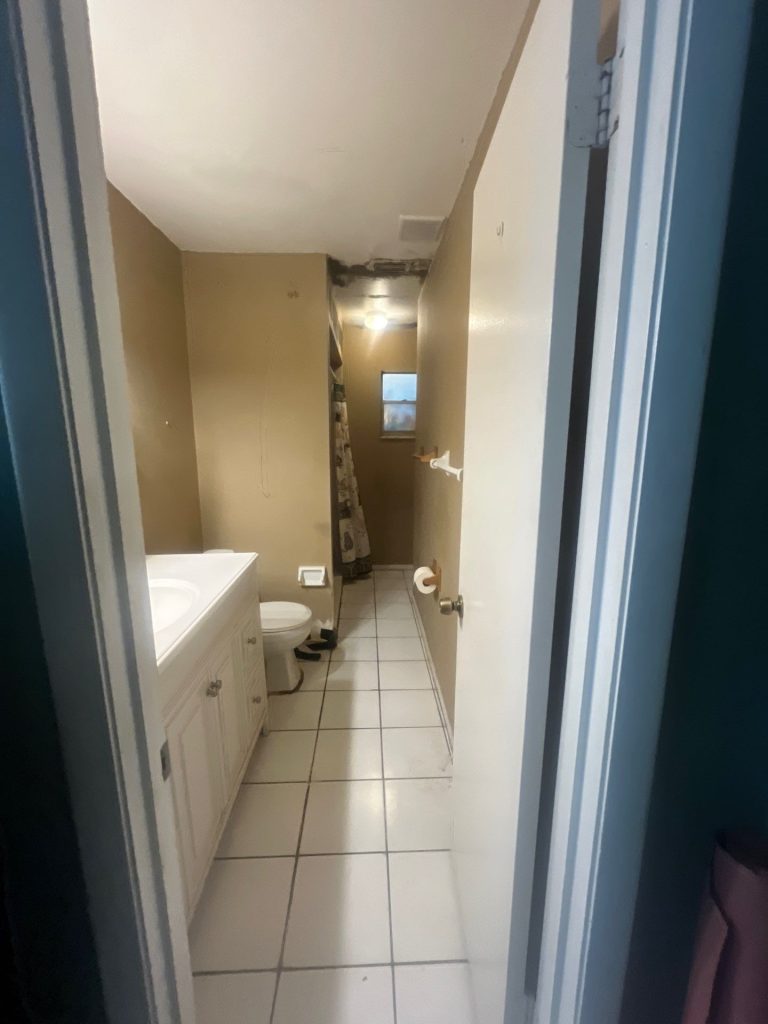
Have you ever walked into your shower area and noticed something wasn’t quite right? Maybe it was a musty smell or some weird staining on the wall. Bathroom water damage can cause serious problems if left unchecked. At One Stop Restoration Of FL, we see these problems daily and know exactly how to fix them. Let’s dive into what causes these moisture problems, how to spot them, and what you can do to prevent them.
Understanding Bathroom Water Damage: Types and Causes
Bathroom water damage can come from many sources. Leaky pipes behind walls often go unnoticed until they’ve created a big mess.
Overflowing toilets or tubs can send liquid seeping into floors and walls. Even high humidity from hot showers can lead to moisture buildup over time.
The most common culprits we see include faulty plumbing connections, worn-out caulking around tubs and showers, and improperly sealed fixtures.
Older homes are especially vulnerable because pipes may have corroded or shifted over the years. Florida’s humid climate doesn’t help either – it creates perfect conditions for moisture-related issues to develop faster than in drier regions.

Signs of Bathroom Water Damage to Watch For
Catching bathroom water damage early can save you thousands in repairs. Keep an eye out for these telltale signs:
- Peeling paint or wallpaper, especially near shower areas
- Warped or soft flooring that feels spongy underfoot
- Stains on ceilings below your wet areas
- Persistent musty odors that won't go away
- Visible mold or mildew growth, especially in corners or grout lines
Don’t ignore small signs! That tiny brown spot on your ceiling might seem minor now, but it could signal big trouble brewing above. We recently helped a client who ignored a small stain only to discover extensive rot in their floor joists that required major structural repairs.
How Water Damage Impacts Your Health and Home
The effects of bathroom water damage go beyond cosmetic problems. When it seeps into your home’s structure, it can weaken wooden supports and corrode metal fasteners. This compromises your home’s structural integrity over time and can lead to expensive repairs.
Health-wise, damp environments become breeding grounds for mold and mildew. These fungi release spores that can trigger allergic reactions, respiratory problems, and other health issues.
Children, elderly people, and those with existing respiratory conditions are especially vulnerable.
Plus, the high humidity created by leaks makes your home less comfortable and can even attract pests looking for leaking sources.
Professional Water Damage Restoration Process
When we tackle bathroom water damage at One Stop Restoration, we follow a proven process to ensure complete recovery.
First, we identify and stop the source – no point in drying things out if it keeps coming in! Next, we remove all standing water using specialized equipment.
The real work begins with thorough drying using industrial dehumidifiers and air movers. We’ll check moisture levels in walls and floors to ensure everything is completely dry before restoration begins.
Finally, we repair or replace affected materials – whether that’s drywall, flooring, or fixtures – and address any mold problems that developed.
Our goal is always to return your space to pre-loss condition or better while preventing future issues.
How to Prevent Bathroom Water Damage: Essential Tips
An ounce of prevention is worth a pound of cure when it comes to bathroom water damage.
Start by checking the caulking around your tub, shower, and sinks every six months and replace it if it’s cracking or peeling. Install a ventilation fan if you don’t have one, and always use it during showers to reduce humidity.
Monitor your bill for unexpected increases – they could signal hidden leaks. Consider installing leak detectors near toilets and sinks for early warnings. And don’t forget about your grout!
Seal it annually to prevent water from seeping between tiles. These simple steps can help you avoid the headache and expense of major restoration projects down the road.
When it comes to protecting your home from bathroom water damage, knowledge and quick action are your best defenses.
If you spot any warning signs, don’t wait – call the professionals at One Stop Restoration right away!
FAQ
How do I prevent water damage before it happens?
Regular maintenance is your best defense! Check your bathroom floor for cracked tiles that might allow water to seep underneath. Install proper ventilation fans to remove excess water vapor after showers. Inspect plumbing connections monthly and replace worn seals. Apply fresh caulking around tubs and showers yearly. These simple steps help prevent costly structural damage down the road.
What are some signs of water damage in your bathroom?
Watch for peeling wallpaper or bubbling paint near shower areas. Discolored or warped bathroom floor sections often indicate hidden problems. Persistent musty odors typically signal mold growth has started. Stains on ceilings below bathrooms are major red flags. If cabinet bases feel soft or spongy, water may be seeping into the wood.
What are the common causes of bathroom water damage?
Leaky pipes and faulty connections top the list! Overflowing toilets can cause water damage quickly, especially black water which contains contaminants. Shower curtains positioned incorrectly let water escape. Even clear water from small leaks causes problems over time. Cracked shower pans or poor grouting between tiles create hidden pathways for moisture. The type of water matters too – clean leaks are easier to address.




